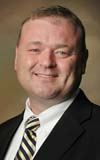MACON — For the first time in 14 years, the “Dance Card” statistical model developed by a Mercer University economics professor and two colleagues was 100 percent accurate in predicting at-large bids to the NCAA Men's Basketball Tournament. The model was co-designed by Dr. Allen Lynch, associate dean of Mercer University's Eugene W. Stetson School of Business and Economics and an associate professor of economics, and colleagues Dr. Jay Coleman, professor of management at the University of North Florida, and Mike DuMond of Charles River Associates Inc. The trio has been crunching the numbers trying to determine which teams the tournament committee selects for at-large berths to the dance for 14 years. Last year, the Dance Card only missed one selection, and this year it accurately predicted all 37 bids, making it 98.6 percent accurate over the past two years. It is more than 93 percent accurate overall.
The predictive accuracy of the model over the past two years has Dr. Lynch intrigued. In 2010, the trio published a paper, titled “Evidence of Bias in the NCAA Tournament Selection and Seeding,” in the journal Managerial and Decision Economics.The paper addressed some of the issues that had led to the “misses” in their previous models, reexamining data on 910 teams from 1999 to 2008. The paper concluded that there was bias for major and mid-major conferences in selection and seeding, as well as evidence of bias toward majors over mid-majors. The paper also found that there was substantial evidence of bias toward teams with some type of committee representation, Dr. Lynch said.
The paper's publication led to an article SI.com in 2010 in which NCAA officials questioned the paper's results. However, the authors' “unbiased” model, which omitted the bias factors found in the paper, accurately predicted all but one at-large bid in 2012 and all 37 in 2013. Overall, the trio's Dance Card has only once missed more than three teams in given year and was more than 93 percent accurate over the past 14 years in predicting the “at-large” berths handed out by the NCAA Tournament Selection Committee. Prior to 2012, the model had accurately predicted all but one at-large bid only two other times.
“We don't know what goes on within the committee, but we do know that the NCAA knew about our paper in 2010, because of some media reports and our responses to those reports,” Dr. Lynch said. “The recent results do appear to show that the committee has taken steps to eliminate the bias and we think that is good news. It shows they were paying attention to the performance data, and that the biases we had observed have not influenced the committee this year.”
For the full listing of the Dance Card, go to dancecard.unf.edu, or follow on Twitter @DanceCard3.
— 30 —










